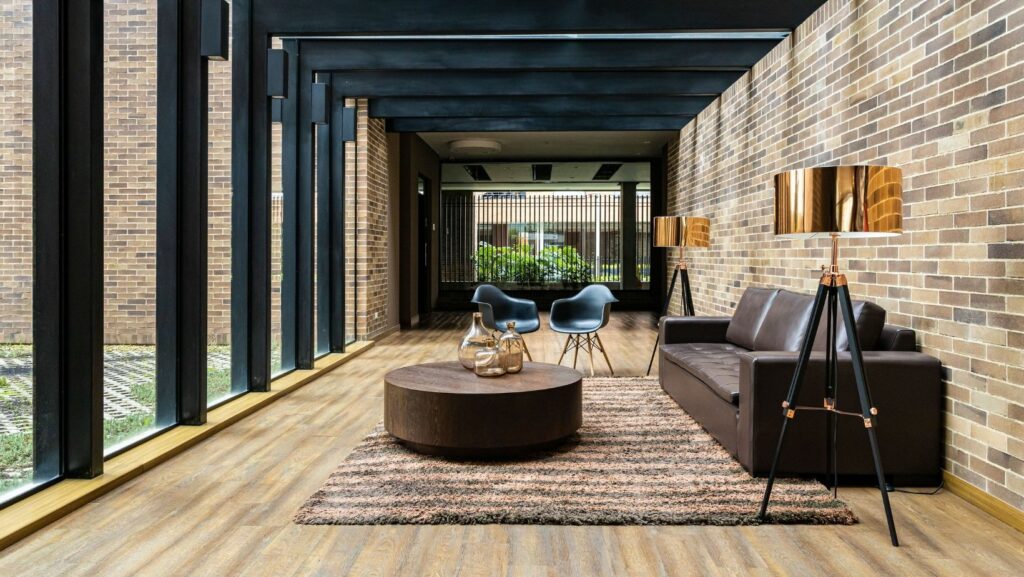 Step into a world where sustainability meets style – the organic living room. Embracing natural materials, eco-friendly furniture, and earthy color palettes, this design trend is all about bringing the outdoors in. Imagine a space where every element is thoughtfully curated to create a harmonious and healthy environment for relaxation and entertainment. In an organic living room, you’ll find furniture crafted from reclaimed wood, organic cotton upholstery, and non-toxic finishes. Plants and natural light play a crucial role in enhancing the ambiance, promoting a sense of well-being and connection to nature.
Step into a world where sustainability meets style – the organic living room. Embracing natural materials, eco-friendly furniture, and earthy color palettes, this design trend is all about bringing the outdoors in. Imagine a space where every element is thoughtfully curated to create a harmonious and healthy environment for relaxation and entertainment. In an organic living room, you’ll find furniture crafted from reclaimed wood, organic cotton upholstery, and non-toxic finishes. Plants and natural light play a crucial role in enhancing the ambiance, promoting a sense of well-being and connection to nature.
Organic Living Room
 In an organic living room, sustainability meets style effortlessly. This design trend champions the use of natural materials, eco-friendly furniture, and earthy color palettes, fostering a harmonious and healthy living environment. Incorporating reclaimed wood furniture, organic cotton upholstery, and non-toxic finishes are central to this trend. By adding plants and maximizing natural light, the organic living room promotes well-being, making it a versatile space where individuals can showcase their unique styles while making eco-conscious choices.
In an organic living room, sustainability meets style effortlessly. This design trend champions the use of natural materials, eco-friendly furniture, and earthy color palettes, fostering a harmonious and healthy living environment. Incorporating reclaimed wood furniture, organic cotton upholstery, and non-toxic finishes are central to this trend. By adding plants and maximizing natural light, the organic living room promotes well-being, making it a versatile space where individuals can showcase their unique styles while making eco-conscious choices.
Natural Materials for Furniture
When it comes to furnishing an organic living room, utilizing natural materials is essential. These elements not only contribute to the eco-friendly aspect but also add a touch of warmth and sophistication to the space.
Wood
Wood is a quintessential material for organic furniture, offering durability and timeless beauty. Opting for pieces made from reclaimed wood not only reduces environmental impact but also adds character with its unique textures and finishes.
Bamboo
Bamboo is another excellent choice for organic furniture due to its sustainability and rapid growth. This versatile material can be crafted into various furniture pieces, from chairs to shelving units, providing a sleek and modern aesthetic while being environmentally friendly.
Eco-Friendly Decor
 Continuing the focus on eco-conscious choices, the organic living room extends its sustainability attributes to its decor. Embracing eco-friendly decor entails opting for items that minimize harm to the environment and human health. By selecting furnishings that are manufactured sustainably and using non-toxic materials, individuals can create a stylish space that supports a healthier indoor environment. In an eco-friendly organic living room, materials play a significant role in achieving sustainability goals. Options such as reclaimed wood furniture not only reduce waste but also add a unique charm and character to the room. This type of furniture is durable, stylish, and contributes to the reduction of carbon footprint. Organic cotton upholstery is another excellent choice as it is made from natural fibers without the use of harmful chemicals, promoting a safer and healthier living space.
Continuing the focus on eco-conscious choices, the organic living room extends its sustainability attributes to its decor. Embracing eco-friendly decor entails opting for items that minimize harm to the environment and human health. By selecting furnishings that are manufactured sustainably and using non-toxic materials, individuals can create a stylish space that supports a healthier indoor environment. In an eco-friendly organic living room, materials play a significant role in achieving sustainability goals. Options such as reclaimed wood furniture not only reduce waste but also add a unique charm and character to the room. This type of furniture is durable, stylish, and contributes to the reduction of carbon footprint. Organic cotton upholstery is another excellent choice as it is made from natural fibers without the use of harmful chemicals, promoting a safer and healthier living space.
Sustainability in Textiles
In line with the organic living room concept, sustainability extends to the choice of textiles used in furnishing the space. Opting for eco-friendly textiles not only enhances the overall aesthetic but also aligns with the eco-conscious ethos of the design trend. Organic cotton, linen, hemp, and jute are popular choices known for their sustainable production processes, minimal environmental impact, and health benefits for occupants.
- Organic Cotton: Known for its softness and breathability, organic cotton is grown without the use of synthetic pesticides or fertilizers. Its cultivation promotes soil health and reduces water consumption compared to conventional cotton farming practices.
- Linen: Renowned for its durability and moisture-wicking properties, linen is derived from the flax plant, a resilient crop that requires minimal water and pesticides. Linen upholstery adds a touch of elegance to the organic living room while contributing to a sustainable lifestyle.
Selecting textiles like organic cotton, linen, hemp, and jute for upholstery and decor accessories in the organic living room not only elevates the visual appeal but also upholds the core values of sustainability and environmental consciousness, creating a space that nurtures both the well-being of its occupants and the planet.

